10 Positively Great Display Ideas for Your Houseplants
Check out these ways to make a bigger impact with your indoor potted displays
Houseplants of all shapes and sizes can brighten a room, help improve air quality and generally bring more life to indoor spaces. How you display houseplants – particularly if you’ve accumulated a lot of them – can have a big impact on whether your houseplant collection looks like an intentional part of your interior design or a haphazard jungle (which has a charm all its own). Take a look at these 10 ideas for potting, grouping and displaying your houseplants in ways that will bring new life to your overall room design.
2. Group smaller pots
Give little containers more oomph by collecting them into a defined area, like on a bench, windowsill or plant rack. In this Brooklyn, New York, apartment, a collection of small to medium-size plants in mixed terra-cotta pots looks much more intentional marching along a bench by a sunny window than if the same potted plants were scattered around the living room. Plus, plants in groups are easier to water.
Give little containers more oomph by collecting them into a defined area, like on a bench, windowsill or plant rack. In this Brooklyn, New York, apartment, a collection of small to medium-size plants in mixed terra-cotta pots looks much more intentional marching along a bench by a sunny window than if the same potted plants were scattered around the living room. Plus, plants in groups are easier to water.
3. Use repetition
Establish themes – all succulents, white pots, baskets or colourful containers – to bring the look of your potted plants together. This works well for grouped plant collections, like this arrangement in Austin, Texas, but can help integrate potted plants placed throughout the house.
Establish themes – all succulents, white pots, baskets or colourful containers – to bring the look of your potted plants together. This works well for grouped plant collections, like this arrangement in Austin, Texas, but can help integrate potted plants placed throughout the house.
You can also use repetition in the plant placement. For shelves, try arranging the same number of plants on each level. Here, the designers used repetition in three ways (same plant type, same containers and same number of plants per shelf) to create a display of orchids that brings life to a small bathroom. Most orchids thrive in bright, indirect light, as shown here.
Learn more about growing orchids at home
Learn more about growing orchids at home
4. Go vertical
You don’t need to invest in a complicated planting system to create a vertical garden. A metal trellis attached to the wall can provide a place for hanging potted plants or for indoor vines to climb. In this loft in Barcelona, Spain, the architects added a metal trellis to the wall spanning floors and hung potted rhipsalis (Rhipsalis sp.) and staghorn fern (Platycerium sp.). As a result, the bare white wall has been transformed into a dynamic, leafy feature.
You don’t need to invest in a complicated planting system to create a vertical garden. A metal trellis attached to the wall can provide a place for hanging potted plants or for indoor vines to climb. In this loft in Barcelona, Spain, the architects added a metal trellis to the wall spanning floors and hung potted rhipsalis (Rhipsalis sp.) and staghorn fern (Platycerium sp.). As a result, the bare white wall has been transformed into a dynamic, leafy feature.
5. Hang a plant ‘chandelier’
Draw the eye upward with the addition of one standout houseplant suspended from the ceiling. Look for trailing varieties, like hoya, pothos, hearts entangled (Ceropegia woodii) or some varieties of rhipsalis that will hang down from the container. If you don’t have a bright spot with a skylight, position the hanging plant near a window.
Draw the eye upward with the addition of one standout houseplant suspended from the ceiling. Look for trailing varieties, like hoya, pothos, hearts entangled (Ceropegia woodii) or some varieties of rhipsalis that will hang down from the container. If you don’t have a bright spot with a skylight, position the hanging plant near a window.
6. Use a hanging plant rack
Another way to bring houseplants to bare walls is to rig up a hanging planter. Systems like this usually don’t come with drainage holes (it would make a mess indoors), so you’ll drop plants in their nursery pots into the containers in the hanging system. This has the advantage of keeping the arrangement flexible, allowing you to easily swap out plants.
You can find these hanging systems through specialty nurseries or online, or put together your own using dowel rods to support multiple potted plant hangers.
Another way to bring houseplants to bare walls is to rig up a hanging planter. Systems like this usually don’t come with drainage holes (it would make a mess indoors), so you’ll drop plants in their nursery pots into the containers in the hanging system. This has the advantage of keeping the arrangement flexible, allowing you to easily swap out plants.
You can find these hanging systems through specialty nurseries or online, or put together your own using dowel rods to support multiple potted plant hangers.
7. Turn a shelf into a plant display
Devoting a floating shelf to your houseplant collection is a great way to save floor space, combine smaller potted plants to make a bigger impact and bring little plants up to eye level.
If you’re hanging a new shelf, position it in an area close to a window, such as in a sunny area of the dining or living room. Mix in other natural items, like shells, or use brass candlesticks, small sculptures, framed pictures or other home accessories to create a vignette.
Devoting a floating shelf to your houseplant collection is a great way to save floor space, combine smaller potted plants to make a bigger impact and bring little plants up to eye level.
If you’re hanging a new shelf, position it in an area close to a window, such as in a sunny area of the dining or living room. Mix in other natural items, like shells, or use brass candlesticks, small sculptures, framed pictures or other home accessories to create a vignette.
8. Look for unused spaces
In this renovated Victorian schoolhouse in Nottinghamshire, England, the owners took down the curtains in the laundry room and repurposed the lower rod into a plant rack. Equipped with potted orchids, basil, succulents and other houseplants, this easily overlooked spot has become an attractive space.
Other often neglected areas that can be good spots for houseplants include the tops of bookshelves, shadowy corners and oddly shaped nooks.
In this renovated Victorian schoolhouse in Nottinghamshire, England, the owners took down the curtains in the laundry room and repurposed the lower rod into a plant rack. Equipped with potted orchids, basil, succulents and other houseplants, this easily overlooked spot has become an attractive space.
Other often neglected areas that can be good spots for houseplants include the tops of bookshelves, shadowy corners and oddly shaped nooks.
9. Deck out your bathroom
Bathrooms often feel more natural with the addition of a plant or two to break up expanses of tile and mirrors. Plus, most houseplants thrive with the additional moisture from the shower.
The designers of this home in London’s Hackney neighborhood took advantage of a skylight above the bath to hang potted donkey tail (Sedum morganianum), staghorn fern (Platycerium sp.), string of bananas (Senecio radicans) and common ivy. As a result, the bath feels like a tranquil mini conservatory. Re-create the look with plants hung from a shower curtain rod or with a hanging trio by a bathroom window.
Low-maintenance plant ideas for bathrooms
Bathrooms often feel more natural with the addition of a plant or two to break up expanses of tile and mirrors. Plus, most houseplants thrive with the additional moisture from the shower.
The designers of this home in London’s Hackney neighborhood took advantage of a skylight above the bath to hang potted donkey tail (Sedum morganianum), staghorn fern (Platycerium sp.), string of bananas (Senecio radicans) and common ivy. As a result, the bath feels like a tranquil mini conservatory. Re-create the look with plants hung from a shower curtain rod or with a hanging trio by a bathroom window.
Low-maintenance plant ideas for bathrooms
10. Ditch the containers
Give an entirely new look to houseplants by replacing their pots with free-form balls made of moss and string. You’ve probably seen kokedama, plants with wrapped root balls that form container-free hanging gardens – a Japanese art. While they resemble works of art, hung like floating islands in a window or resting on a sill, kokedama are surprisingly easy to make and care for.
To water, dunk the root ball in water, allowing it to soak for a few minutes. Squeeze gently to release excess water. Repeat every few days or weekly, depending on root ball size, climate and plant variety.
Give an entirely new look to houseplants by replacing their pots with free-form balls made of moss and string. You’ve probably seen kokedama, plants with wrapped root balls that form container-free hanging gardens – a Japanese art. While they resemble works of art, hung like floating islands in a window or resting on a sill, kokedama are surprisingly easy to make and care for.
To water, dunk the root ball in water, allowing it to soak for a few minutes. Squeeze gently to release excess water. Repeat every few days or weekly, depending on root ball size, climate and plant variety.
TELL US
Share a photo of your houseplant collection in the Comments below.
Share a photo of your houseplant collection in the Comments below.


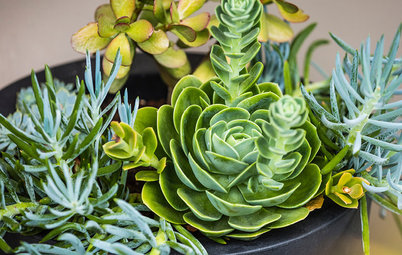
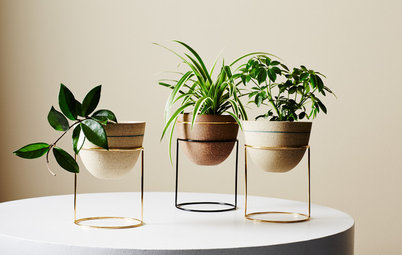
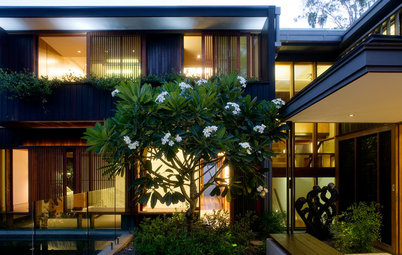
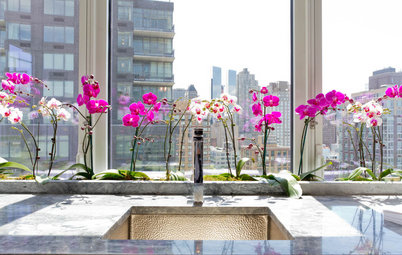
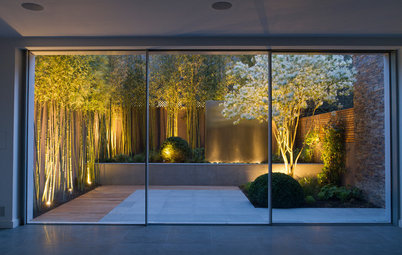
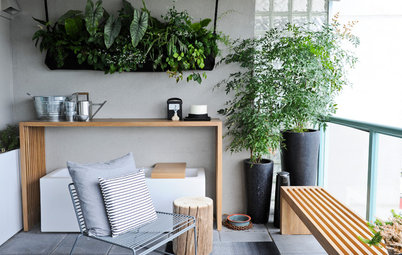
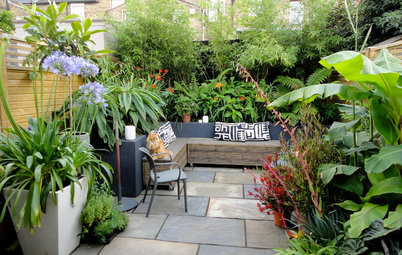
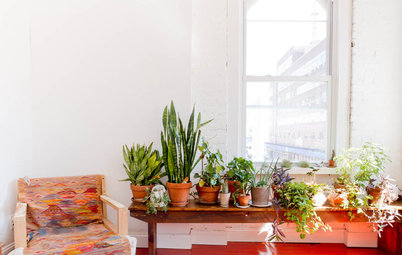
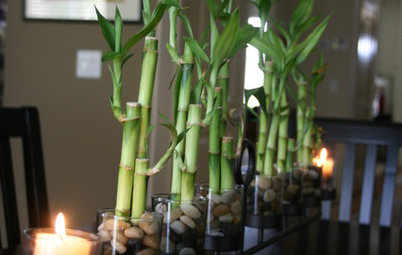
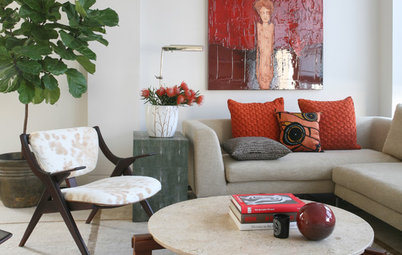
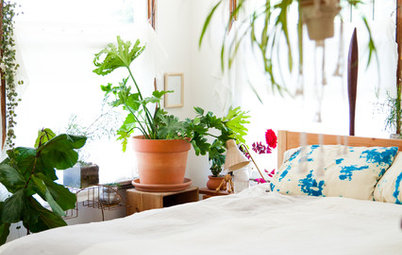
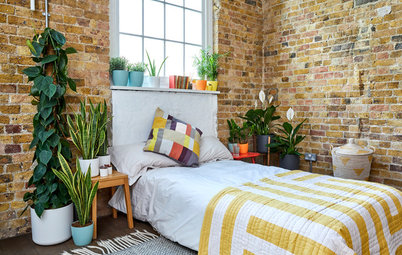
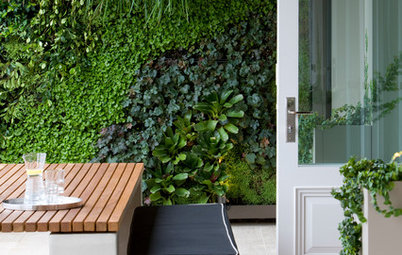
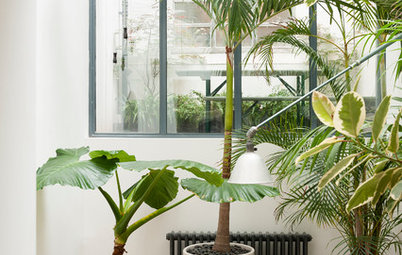
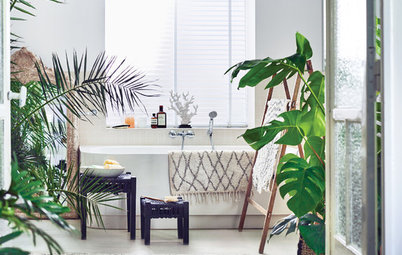
By ‘personality’ I mean both its growth habit and light requirements. If you already have the houseplant, research whether it’s a sun lover or can tolerate darker areas before you scout for potential placements. Once you’ve identified areas with bright light (direct and indirect), medium light and low light, and the plants that thrive in each exposure, note each plant’s growth habit and size.
Position ‘trailers’, like pothos and string of pearls (Senecio rowleyanus), on high shelves where they can spill down. Display desktop-size plants close to eye level, such as on a mantel or midlevel shelf, so they can be appreciated up close. Reserve larger structural plants, like fiddleleaf fig (Ficus lyrata) or a large-scale cactus, for areas like empty corners or the space behind the couch.